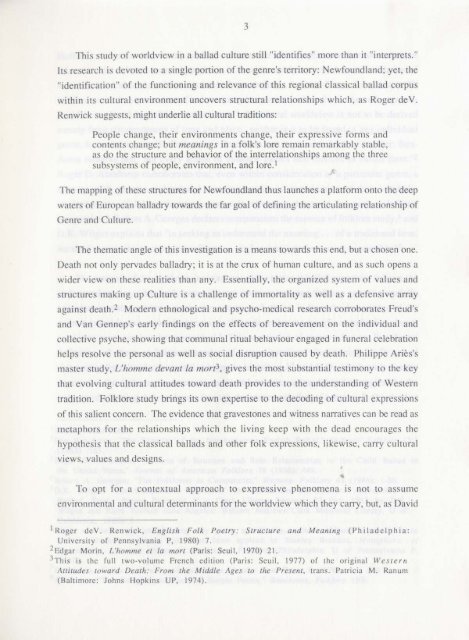Untitled - Memorial University's Digital Archives - Memorial ...
Untitled - Memorial University's Digital Archives - Memorial ...
Untitled - Memorial University's Digital Archives - Memorial ...
Create successful ePaper yourself
Turn your PDF publications into a flip-book with our unique Google optimized e-Paper software.
This study of worldview in a ballad culture still "identifies" more than it "interprets."<br />
Its research is devoted to a single portion of the genre's territory: Newfoundland; yet, the<br />
"identification" of the functioning and relevance of this regional classical ballad corpus<br />
within its cultural environment uncovers structural relationships which, as Roger deV.<br />
Renwick suggests, might underlie all culturallraditions:<br />
People change, their environmenls change, their expressive forms and<br />
contents change; but meanings in a folk's lore remain remarkably stable,<br />
as do the structure and behavior of the interrelationships among the three<br />
subsystems of people, environment, and lore. t<br />
The mapping of these Slnlctures for Newfoundland thus launches a platfoml onlO the deep<br />
waters of European balladry IOwards the far goal of defining the articulating relationship of<br />
Genre and Culture.<br />
The thematic angle of this investigation is a means towards this end, but a chosen one.<br />
Death not only pervades balladry; it is at the crux of human culture, and as sllch opens a<br />
wider view on these realities than any. Essentially, the organized system of values and<br />
structures making up Culture is a challenge of immortality as well as a defensive array<br />
against death.2 Modern ethnOlogical and psycho-medical research corroborates Freud's<br />
and Van Gennep's early findings on the effects of bereavement on the individual and<br />
colleclive psyche, showing that communal ritual behaviour engaged in funeral celebration<br />
helps resolve the personal as well as social disruption caused by death. Philippe Aries's<br />
master study, L'homme devan! fa mort 3 , gives the most substantial testimony to the key<br />
that evolving cultural attitudes toward death provides to the understanding of Western<br />
tradition. Folklore study brings its own expertise to the decoding of cultural expressions<br />
of this salient concern. The evidence that gravestones and witness narratives can be read as<br />
metaphors for the relationships which the living keep with the dead encourages the<br />
hypothesis that the classical ballads and other folk expressions, likewise, carry cultural<br />
views, values and designs.<br />
To opt for a contextual approach to expressive phenomena is not to assume<br />
environmental and cultural determinants for the worldview which they carry, but, as David<br />
1 Roger deY, Rellwiek, English Folk. Poelry: Slructure and Meaning (Philadelphia:<br />
University of Pennsylvania P, 19RO) 7.<br />
2Edgar Morin, L'homme ella mort (Paris: Seuil. 1970) 21.<br />
3This is the full two-volume French edition (Paris: Seuil, 1977) of Ihe original lVestern<br />
Al/jlUdes toward Death: From the Middle Ages to the PrCUnI, tnlllS. Patricia M. Ranum<br />
(Baltimore: Johns Hopkins UP, 1974).

















